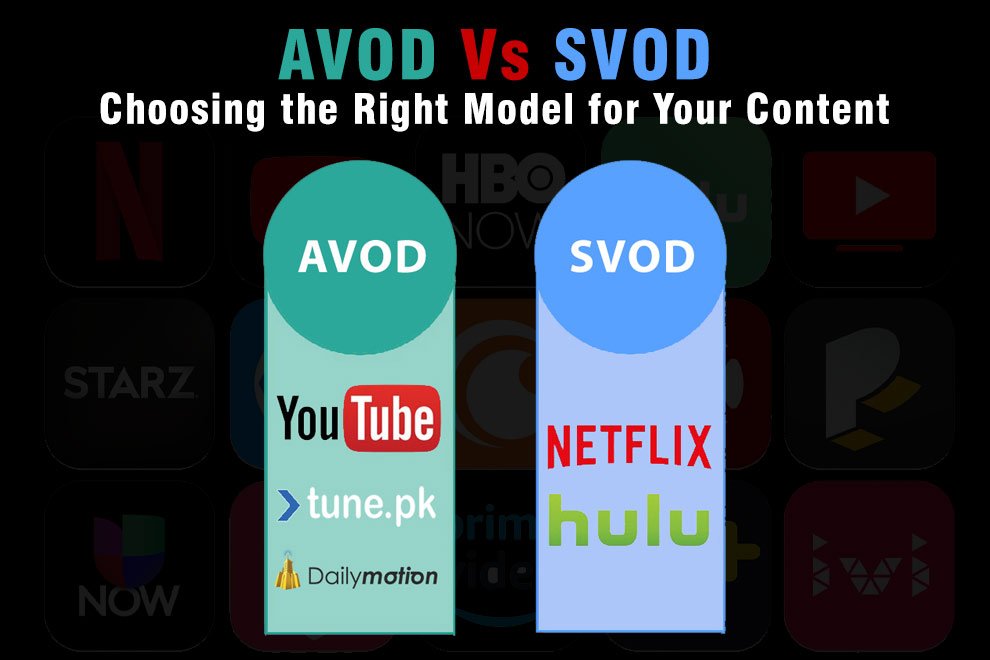Depending on your revenue objectives, audience preferences, and distribution plans, you can choose between subscription video-on-demand (SVOD) and ad-supported video-on-demand (AVOD) models for content distribution.
In this guide, we will go over the benefits and factors to consider when it comes to AVOD vs SVOD to help you choose which is best for your content.
Understanding AVOD and SVOD Models
AVOD (Ad-Supported Video on Demand)
Viewers can access content on AVOD platforms for free, because advertising is the primary income source for the model. While there is no subscription cost, advertisements will appear at specific points throughout the TV show or movie. Popular AVOD platforms include YouTube, Hulu (with ads), and Roku Channel.
SVOD (Subscription Video on Demand)
To access content on SVOD platforms, users must pay a subscription fee, usually once a month or once a year. Members get unrestricted access to a content library and ad-free viewing. Well-known SVOD services include Disney+, Netflix, and Amazon Prime Video.
Content Type and Audience Preferences
AVOD
Broad appeal and high viewership potential content are ideal for AVOD models. Because they provide free content access, ad-supported platforms draw a sizable audience and are perfect for reaching various viewers. However, AVOD platforms are also appropriate for specialized or niche content targeting a more limited audience.
SVOD
SVOD models are perfect for premium content that appeals to both broad fan bases or specific niche audiences. Customers are prepared to pay a subscription fee in exchange for having exclusive access to excellent, ad-free content. SVOD platforms are incredibly well-liked by viewers ready to spend money on enjoyable content and value uninterrupted viewing experiences.
Revenue Generation and Monetization
AVOD
Advertising is the primary source of income for AVOD platforms; advertisers must pay to reach the platform’s audience. Revenue is usually calculated using click-through rates, engagement metrics, and ad impressions. Even though AVOD platforms provide free content access, factors like audience demographics, ad inventory, and ad placement can affect revenue potential.
SVOD
SVOD platforms receive funding from subscribers in the form of subscription fees. Content producers and platform operators benefit from a steady, predictable, and recurring revenue stream. Although SVOD platforms provide ad-free viewing experiences, the competition and saturation of content in the SVOD market may make it difficult to draw in new members and keep existing ones.
Content Licensing and Distribution Strategy
AVOD
Content producers can reach a broad audience and profit from their work by using AVOD models to monetize their work with advertising. Content producers can negotiate flat licensing fees or receive a share of advertising revenue in exchange for licensing their work to AVOD platforms. In addition, revenue-sharing plans based on content performance might be available on AVOD platforms.
SVOD
SVOD models allow content producers to earn money directly from subscribers. They can distribute their work concurrently across several platforms or license it exclusively to SVOD services. SVOD platforms usually pay content creators licensing fees or royalties, which are determined by various factors like viewership, engagement, and subscriber retention.
Viewer Experience and Engagement
AVOD
A vast spectrum of viewers can access content on AVOD platforms because it is free. Ads, however, may cause playback pauses for viewers, which may detract from the overall viewing experience. Ad-supported platforms use targeted advertising to show viewers relevant ads that increase viewer engagement and generate income.
SVOD
SVOD platforms provide viewers with an ad-free viewing experience so they can watch content continuously. A curated library of content catered to subscribers’ interests and preferences increases satisfaction and engagement. Personalized recommendations and top-notch content are the main features that SVOD platforms offer to keep users interested and loyal.
Market Trends and Industry Landscape
AVOD
The proliferation of digital media consumption and the rising demand for free, ad-supported content drive the rapid growth and adoption of AVOD models. Advertisers are heavily investing in AVOD platforms to reach audiences at scale and take advantage of opportunities for targeted advertising. However, AVOD platforms do have to contend with issues like ad fraud, ad-blocking software, and competition for advertising funds.
SVOD
SVOD models still dominate the streaming industry, and the top platforms keep up their competitive advantage by investing in original content, global expansion, and technological innovation. Subscriber growth and revenue for SVOD platforms are fueled by subscribers’ willingness to pay for premium content and exclusive access to popular titles. SVOD platforms do, however, have to contend with issues like market saturation, churn management, and content licensing costs.
In conclusion, various factors, including content type, audience preferences, revenue targets, and distribution strategy, influence the decision between AVOD and SVOD models.
AVOD models are ideal for reaching a large audience and monetizing content through advertising revenue because they provide free access to content subsidized by advertising.
SVOD models are perfect for generating revenue from specialized or exclusive content with a devoted following. They require viewers to pay a subscription fee for ad-free access to premium content. The ideal model for your content will ultimately depend on your audience’s demands and your unique goals.










